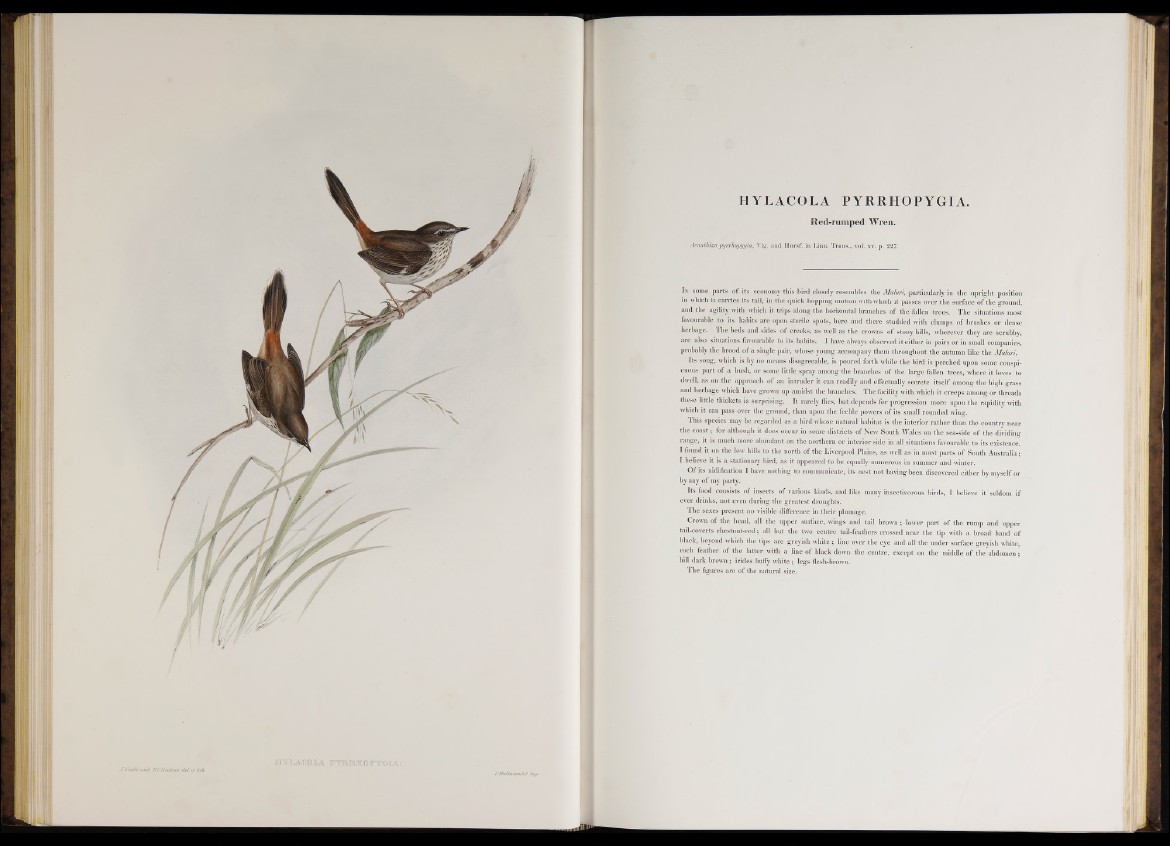
j:G onU a n d JX C R iekitr d e l f | Mu.
HYLACOLA PYRRHOPYGIA.
Red-rumped Wren.
Acanthiza pyrrhopygia, Vig. and Horsf. in Linn. Trans., vol. xv. p. 227.
In some parts o f its economy this bird closely resembles the Maluri, particularly in the upright position
ih which it carries its tail, in the quick hopping motion with which it passes over the surface o f the ground,
and the agility with which it trips along the horizontal branches o f the fallen trees. The situations most
favourable to its habits are open sterile spots, here and there studded with clumps o f brushes or dense
herbage. The beds and sides o f creeks, as well as the crowns o f stony hills, wherever they are scrubby,
are also situations favourable to its habits. I have always observed it either in pairs or in small companies,
probably the brood o f a single pair, whose young accompany them throughout the autumn like the Maluri.
Its song, which is by no means disagreeable, is poured forth while the bird is perched upon some conspicuous
part o f a bush, or some little spray among the branches of the large fallen trees, where it loves to
dwell, as on the approach of an intruder it can readily and effectually secrete itself among the high grass
and herbage which have grown up amidst the branches. The facility with which it creeps among or threads
these little thickets is surprising. It rarely flies, but depends for progression more upon the rapidity with
which it can pass over the ground, than upon the feeble powers o f its small rounded wing.
This species may be regarded as a bird whose natural habitat is the interior rather thau the country near
the coast; for although it does occur in some districts o f New South Wales on the sea-side o f the dividing
range, it is much more abundant on the northern or interior side in all situations favourable to its existence.
I found it on the low hills to the north o f the Liverpool Plains, as well as in most parts o f South Australia;
I believe it is a stationary bird, as it appeared to be equally numerous in summer and winter.
Of its nidification I have nothing to communicate, its nest not having been discovered either by myself or
by any of my party.
Its food consists of insects of various kinds, and like many insectivorous birds, I believe it seldom if
ever drinks, not even during the greatest droughts.
The sexes present no visible difference in their plumage.
Crown o f the head, all the upper surface, wings and tail brown ; lower part o f the rump and upper
tail-coverts chestnut-red; all but the two centre tail-feathers crossed near the tip with a broad band o f
black, beyond which the tips are greyish white ; line over the eye and all the under surface greyish white,
each feather o f the latter with a line o f black down the centre, except on the middle of the abdomen;
bill dark brown; irides huffy white ; legs flesh-brown.
The figures are o f the natural size.